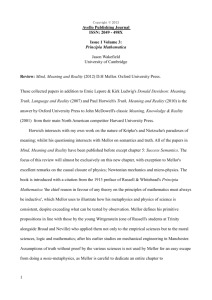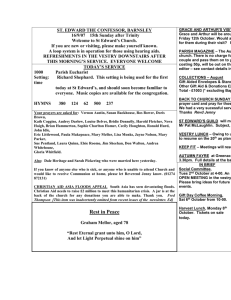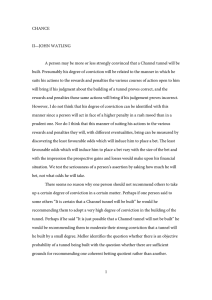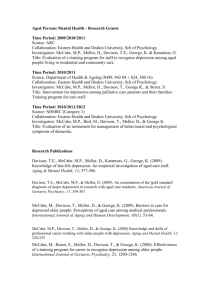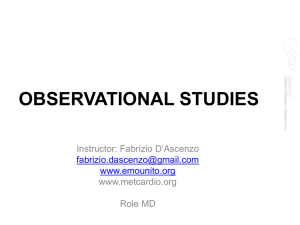Review of D.H. Mellor`s
advertisement
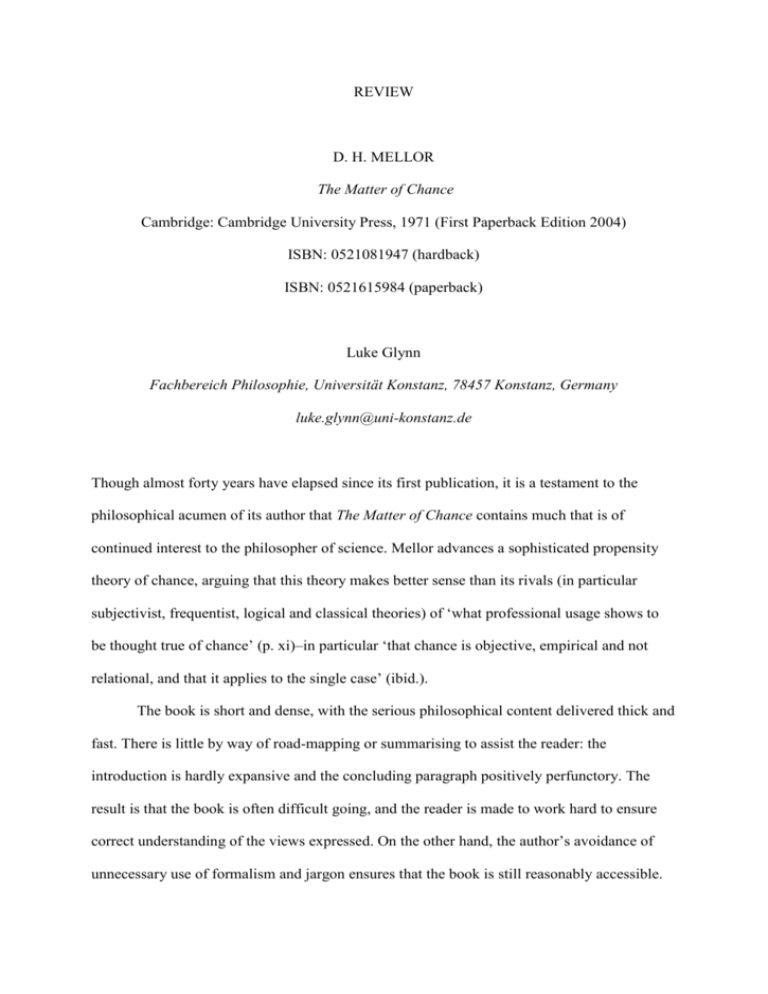
REVIEW
D. H. MELLOR
The Matter of Chance
Cambridge: Cambridge University Press, 1971 (First Paperback Edition 2004)
ISBN: 0521081947 (hardback)
ISBN: 0521615984 (paperback)
Luke Glynn
Fachbereich Philosophie, Universität Konstanz, 78457 Konstanz, Germany
luke.glynn@uni-konstanz.de
Though almost forty years have elapsed since its first publication, it is a testament to the
philosophical acumen of its author that The Matter of Chance contains much that is of
continued interest to the philosopher of science. Mellor advances a sophisticated propensity
theory of chance, arguing that this theory makes better sense than its rivals (in particular
subjectivist, frequentist, logical and classical theories) of ‘what professional usage shows to
be thought true of chance’ (p. xi)–in particular ‘that chance is objective, empirical and not
relational, and that it applies to the single case’ (ibid.).
The book is short and dense, with the serious philosophical content delivered thick and
fast. There is little by way of road-mapping or summarising to assist the reader: the
introduction is hardly expansive and the concluding paragraph positively perfunctory. The
result is that the book is often difficult going, and the reader is made to work hard to ensure
correct understanding of the views expressed. On the other hand, the author’s avoidance of
unnecessary use of formalism and jargon ensures that the book is still reasonably accessible.
In the following, I shall first summarise the key features of Mellor’s propensity theory,
and then offer a few critical remarks.
I
Propensities, according to Mellor (p. 63), are dispositional properties of persisting entities
(which include the ‘common physical things with which science begins its enquiries’–ibid.).
The attribution of a dispositional property F (whether a propensity or otherwise) to an entity a
at time t entails the truth of a subjunctive (or counterfactual) conditional of the form ‘if a were
involved in a situation of kind K at time t, the situation would have the characteristic property
P’ (p. 64). In Mellor’s terminology, the property P is the display of the disposition, whilst the
situation that bears P is a trial (p. 68). Illustration: fragility is a dispositional property that one
might ascribe to a glass at 1pm. Such an ascription entails the truth of the subjunctive ‘if the
glass were dropped on a hard floor at 1pm, then it would break’. The display of the glass’s
fragility, namely its breaking, is elicited by a trial of the kind dropping of the glass on a hard
floor.
Propensities differ from other dispositions in one crucial respect: they have as their
displays, not events (such as breakings), but rather chance distributions over sets of possible
events (pp. 66-7). Thus bias is a propensity that might be ascribed to coin a (which being the
bearer of a propensity is called a chance set-up–p. 67). The display of the coin’s bias is a
certain chance distribution Pa over the set of possible events {Heads, Tails, Edge}. This
display would be elicited by a chance trial of the kind flipping with a standard flipping device.
An obvious question arises as to why we should regard some dispositional properties
to be displayed in events, whilst others (propensities) are displayed in chance distributions
over events. Mellor’s response: ‘[p]hysical dispositions of objects […] are invariable in their
display’ (p. 65). By this he means that any object failing to display a disposition in a situation
or trial of the appropriate kind is thereby shown not to have the disposition at that time (pp.
64-5). Thus: ‘[a] glass that does not break when [suitably] dropped is at that time not fragile’
(p. 68). But, by the very nature of chance set-ups, trials upon them have variable results
(ibid.). Dispositional properties of chance set-ups cannot therefore be displayed in these
results, but must instead be displayed in the chance distributions over the various possible
results, which are invariable (given an appropriate kind of trial).
Dispositional property ascriptions (including propensity ascriptions) can be genuinely
explanatory provided that they can be made on grounds other than the display that they are
intended to explain (the ‘dormative virtue’ explanation of a drug’s soporific effect is
problematic to the extent that we are ignorant of such alternative grounds–p. 65). Thus the
scientifically respectable, explanatory, dispositions are those that can be ascribed on the basis
of their nomic connections with other scientifically respectable properties of an object (pp.
65-6, 104-5). For example, a glass’s shattering can be explained in terms of its fragility
because the latter is lawfully connected to such further properties as molecular structure.
That scientifically respectable dispositions are ascribable on grounds other than their
displays is a corollary of a principle that Mellor calls ‘connectivity’, which he claims
(plausibly enough) to govern the scientific characterisation of physical systems. According to
this principle, two physical systems cannot differ in a single property only (p. 115). The
principle is regulative rather than empirical (pp. 118-9, 174): a scientific characterisation that
was incompatible with it would simply be rejected as inadequate. Connectivity thus implies
that any scientifically respectable property of a physical system supervenes upon its other
such properties.
Since Mellor claims that propensities are respectable scientific properties, he holds
them to be subject to connectivity (pp. 120-1). He shows how this allows us to pin down
certain chance distributions that display them. As an example, he considers the bias of a coin
(pp. 122-7). Bias, being a respectable propensity, is nomically connected to other properties of
a coin, such as its centre of gravity, and its magnetisation. Thus suppose we have a physical
system, coin a, to be flipped by a standard flipping device. For simplicity suppose that Heads
and Tails are the only possible results of this trial (there is no chance of Edge). The bias of the
coin is thus displayed in the chance distribution Pa = <pa(Heads), pa(Tails)>. Now suppose
that I write ‘T’ in chalk on the heads side and ‘H’ on the tails side of the coin. And let us
suppose that such superficial markings are not connected to bias. Call the resulting physical
system ‘b’ (obviously a and b are not distinct–but this does not prevent the application of
connectivity). Let H be the proposition that b lands H side up, and let the bias of b be
displayed in the chance distribution Pb = <pb(H), pb(T)> to which a standard flip gives rise.
Finally, suppose that every true proposition ascribing a property connected to bias to the
heads side of a is true also of the H side of b (and there are no more true propositions
ascribing properties connected to bias to the H side of b). Likewise for the tails side of a and
the T side of b. Then connectivity implies that pa(Heads) = pb(H) (and pa(Tails) = pb(T)). But
note that the H side of b just is the tails side of a. Consequently, we get the result that
pa(Heads) = pa(Tails) = ½. Connectivity thus implies that a symmetric bias (as measured by
the chance distribution to which it gives rise) follows from symmetry in all respects connected
to bias.
Having shown how connectivity acts as a substantive constraint upon propensities,
Mellor turns to his final two tasks which are, first, to argue that propensities may be displayed
even in worlds with deterministic microdynamics (pp. 151-7) and, second, to show that his
propensity view is compatible with Humeanism (pp. 157-74). I shall discuss the second of
these arguments in greater detail below.
II
Some critical remarks. The first concerns Mellor’s claim that dispositions are invariable in
their display. It is not clear what justifies this claim. Certainly Mellor does not marshal
linguistic evidence concerning everyday ascriptions of dispositional properties in support of
it. Indeed, at one point (p. 65) he seems to suggest that it is merely to be taken stipulatively.
But to take it as such is problematic because invariability is Mellor’s only reason for
distinguishing propensities from deterministic dispositions. This distinction is critical to
Mellor’s account, for his central idea is that propensities explain the chance distributions that
are their displays in a manner exactly analogous to that in which deterministic dispositions
explain the events (e.g. the breakings, dissolvings, and fallings-asleep) that are their displays.
Just as the glass’s fragility explains its breaking when dropped, so the coin’s bias explains its
chance ½ of landing heads when flipped.
But if there is no good reason for supposing invariability, then we can’t be sure that
this is the correct analogy. Indeed, I would say that it is fairly clearly incorrect. For note that
all dispositions, whether deterministic or not, give rise to (possibly trivial) chance
distributions over the possible results of the trials that elicit their displays. It seems to me,
therefore, that the explanatory relationship between the fragility of the glass and the trivial
chance distribution to which (we might suppose) a dropping of the bottle would give rise is
the proper model for that between the bias of a coin and the non-trivial chance distribution
that a flipping of it would yield.
If this is correct, then the substantial effort that Mellor invests throughout the book to
make compelling the thesis that deterministic dispositions can be genuinely explanatory of
their results is of little help in demonstrating that propensities are explanatory of chance
distributions. Nor is it at all obvious how such a demonstration would go.
A second critical observation is that, insofar as Mellor’s appeal to dispositions really
provides us with a deep metaphysical account of chance, that account just seems to be false. It
has been seen that Mellor sketches a (somewhat misleading) picture of the relationship of
chance distributions to dispositional properties called propensities. But one might wonder
whether he has thereby provided an account of what a chance distribution is. Certainly he
does not intend to reduce chances to dispositions. He is quite clear that the two are distinct (p.
71)–the propensity is the disposition, the chance distribution its display. In general the things
that display dispositions cannot plausibly be reductively analysed in terms of the dispositions
themselves–the notion of an event is not plausibly analysed in terms of deterministic
dispositional properties of objects. And, although an analysis of dispositions in terms of their
displays may well be plausible, it is not available to someone who like Mellor aims to give an
illuminating account of chance as the display of a dispositional property.
So Mellor hasn’t given a reductive analysis of chance. Nor, it appears, has he sketched
a theoretical constraint upon chance in terms of disposition. It seems that Mellor (anticipating
Lewis [1980]), takes a fully adequate implicit definition of chance to be that in terms of its
role in guiding reasonable partial belief (e.g. pp. 2-3, 52). The further claim that ‘[k]nowledge
of [...] propensity on the present theory is what in suitable circumstances makes reasonable
the having of some particular partial belief’ (p. 2; see also p. xii) seems, if anything, to have
the status of an a posteriori identification of propensity as that which plays the chance-role.
On the face of it, this in itself seems puzzling. For, on the one hand, Mellor
distinguishes chance from propensity but, on the other, propensity is taken to be the player of
the chance-role in guiding reasonable credence. So perhaps we have here at last a substantive
metaphysical thesis–Mellor proposes neither a reduction of chance nor sketches a constraint
upon it, but rather recommends a metaphysical elimination. Thus: ‘[t]he bias of the coin
replaces the chance distribution as the feature of the world which warrants some partial
beliefs rather than others in events that are outcomes of the toss’ (p. 70). Mellor later says of
the distinction between chance and propensity that it ‘must be drawn if only to propose a
change of usage that might make it redundant’ (pp. 81-2), and has earlier said that propensity
‘may in due course displace chance distribution as the primitive objective concept’ (p. 62).
The chance distribution, which is taken to be the display of the propensity, is merely ‘the
measure of [...] reasonable partial belief’ (p. 2), and Mellor speaks of his intention as having
been to ‘identify chance with warranted partial belief’ (p. 72).
If this interpretation is correct, then Mellor does after all furnish a deep metaphysical
account of chance–or rather he makes a deep metaphysical claim about it (namely that it drops
out of the ontology altogether, replaced by propensity which is a rather different sort of thing).
The trouble is that, if this is the metaphysical thesis he indeed intends, then I think it is an
incorrect thesis. If we must take only one of propensity and chance as the primitive objective
concept, there are much better reasons to choose the latter.
This is not the place to attempt a full defence of that claim. I wish merely to point out
that, concerning Mellor’s ‘demonstrations’ of the two principal virtues he claims for his
propensity theory–first, that it allows the derivation of classical probabilities (such as the
chance ½ of a symmetric coin landing heads when tossed) without appeal to ignorance or
insufficient reason and, second, that it explains how objective features of the world can
constrain reasonable partial belief–neither makes essential appeal to propensities and,
moreover, his demonstration of the second does make essential reference to frequencies. Far
from showing that chance is eliminable in favour of propensity, Mellor’s arguments only
serves to lend plausibility to a (sophisticated) frequentist analysis of the former.
With regard to Mellor’s derivation of classical chance distributions, nothing in it really
turns upon such distributions being displays of respectable dispositional properties. Of course
his claim that they are allows him to bring to bear the plausible principle of connectivity to
constrain these distributions by constraining the corresponding propensities. But someone
rejecting this claim can ensure that the chance distributions are similarly constrained just so
long as she subscribes to the supervenience of the chance on the non-chance properties of a
physical system. And, irrespective of whether chances are grounded in propensities, such
supervenience is highly plausible and indeed will be entailed by, for example, a sophisticated
frequentism (such as Lewis’s ([1994]) Best System Analysis). The appeal to propensities is
quite superfluous.
Now consider Mellor’s claim that his theory accounts for the constraint of reasonable
partial belief by objective features of the world. According to Mellor, it is in virtue of the truth
of a probabilistic law that it is uniquely reasonable to have degree of belief p in an appropriate
trial on a chance set-up of kind A resulting in an outcome of kind B (p. 164). His argument
that this is so appeals to the fact that a gambler who is constrained to aim at avoiding a loss
rather than making a profit and who repeatedly bets on As being accompanied by Bs (on
appropriate trials) will, with arbitrarily high chance, be arbitrarily close to breaking even after
a sufficient number of bets, provided that she chooses a coherent betting quotient equal to the
probability p (pp. 160-5). Now there are several worries about Mellor’s argument, not least
concerning the reference to the ‘arbitrarily high chance’ of breaking even. But the important
point to press is that it is entirely unclear that the gambler can expect to break even by
adopting such a strategy unless the probabilistic law in question is made true by facts about
the frequency with which Bs accompany As (or perhaps by some sort of non-Humean ‘partial
compulsion’, resort to which Mellor is keen to avoid, pp. 157-8).
Indeed, a frequentist conception of probabilistic law seems to be the one that Mellor is
relying upon. For, although he insists that probabilistic laws are not merely assertions of
frequent conjunctions (p. 160), his point seems only to be that an adequate Humeanfrequentist account of laws must discriminate genuine probabilistic laws (which support
subjunctive conditionals) from mere frequencies that are not genuine laws (and do not support
subjunctives) (pp. 164, 171-2). Such a Humean-frequentist view would accommodate
Mellor’s discrimination between those (connected) properties of a chance set-up that are
relevant to determining the chance distribution resulting from a trial upon it from those
properties that are not. This may be behind Mellor’s admission that his account can be
reconciled with a sophisticated frequentism (p. 2).
I have suggested that it is only by virtue of a probabilistic law’s being made true by
frequency facts that a probability distribution it entails can constrain reasonable partial belief
(see Lewis [1994]). I have also said that Mellor does indeed appear to rely upon a frequentist
conception of probabilistic law. Indeed, the sort of probabilistic law that Mellor seems to have
in mind is one that gives, as a function of the connected properties of a chance set-up, the
chance distribution that displays its propensity (pp. 172-3). For example, Mellor supposes we
might know (within limits of imprecision and holding other connected properties fixed) that
there is a certain quantitative relationship between the centre of gravity of a coin and its
chance of heads on a standard flip (p. 126). But, on this conception, the probabilistic laws
relate the connected properties to the chance distributions directly, making redundant an
appeal to propensity as a ‘primitive objective concept’.
So it seems to be facts about frequencies rather than propensities that do the real work
in making probabilistic laws true and constraining reasonable partial belief, the latter of which
roles Mellor himself takes to be definitive of chance. It therefore seems misguided of him to
seek an account of chance in terms of propensity, let alone an elimination of the former in
favour of the latter.
Although I have raised objections to Mellor’s use of the notion of propensity to
explicate that of chance, the book still contains much of interest. In particular, Mellor
provides as compelling a case as any that has been advanced for the scientific respectability of
dispositional properties, and in particular for their ability to figure in genuinely illuminating
explanations (of the events which are their results even if not of the chance distributions to
which they give rise). And, although I have been unable to discuss them here, Mellor’s
discussions of the nature of partial belief (Chapters 1-2), of imprecision and inexactness
(Chapter 6), and of the relationship between determinism and chance (Chapter 8) are all
highly illuminating.1
References
Lewis, D. [1980]: ‘A Subjectivist’s Guide to Objective Chance’, in R. C. Jeffrey (ed.), Studies
in Inductive Logic and Probability, Vol. 2, Berkeley, CA: University of California Press, pp.
263-93.
Lewis, D. [1994]: ‘Humean Supervenience Debugged’, Mind, 103, pp. 473-90.
1
Funding: Deutsche Forschungsgemeinschaft (SP279/15-1).
